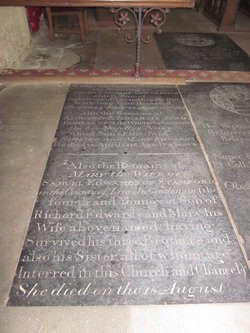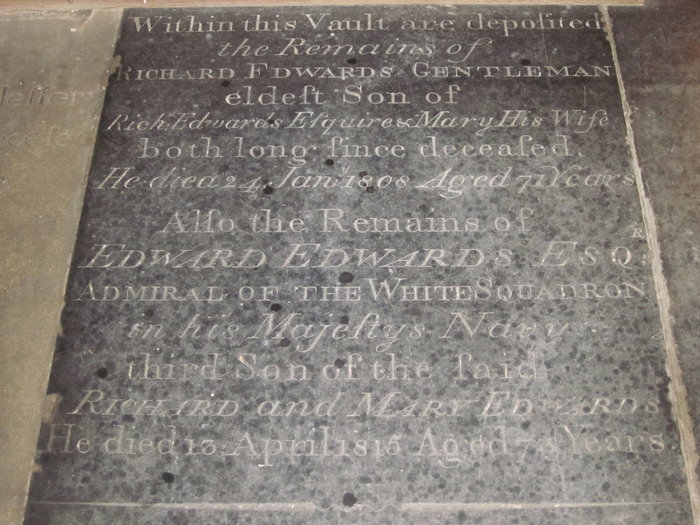British Naval Commander. A career officer with nearly 30 years at sea, he is best known - indeed notorious - for commanding the HMS Pandora in its search for the mutineers of the HMS Bounty (1790 to 1791). Although the mission was partially successful, tales of Edwards' cruelty and the disastrous end of the voyage have marked him in history as a malevolent figure. On March 16, 1790, Lt. Commander William Bligh reported the mutiny on the Bounty to the British Admiralty in London. King George III immediately commanded that the Bounty be returned and the mutineers brought to justice, and Edwards was chosen for the task. Back in May 1782, a year after his promotion to Captain, he had ruthlessly put down a mutiny on his own ship, the HMS Narcissus; of the sailors he didn't have killed on the spot, six were later hanged and two flogged to death. This incident instilled in him a murderous hatred of mutineers and, in the eyes of the Admiralty, made him uniquely qualified to hunt for the Bounty gang. Rather than the "two sloops" recommended by the King, he was given command of the Pandora, a 24-gun frigate with a crew of 120. The search party sailed from Portsmouth on November 7, 1790; rounding Cape Horn into the Pacific, the Pandora reached Tahiti on March 15, 1791. Within six weeks Edwards had rounded up all 14 of the surviving Bounty men on the island: mutineers Thomas Burkett, Thomas Ellison, Henry Hillbrant, John Millward, William Muspratt, Richard Skinner, and John Sumner; and loyalists Michael Byrne, Joseph Coleman, Peter Heywood, Thomas McIntosh, James Morrison, Charles Norman, and George Stewart, all of whom had been kept on the Bounty against their will. Two more men were accounted for: mutineers Charles Churchill and Matthew Thompson, who had been killed in Tahiti the previous year. But there was no sign of ringleader Fletcher Christian, or the Bounty. Edwards imprisoned all the Bounty men, a grave injustice because he knew which ones were innocent or guilty (through Bligh's accounts of the mutiny and through the presence on the Pandora of Midshipman Thomas Hayward, who had survived being put off the Bounty with Bligh). Worse still, they were brutally chained inside a brig of the Captain's own design: "Pandora's Box", a small wooden cage above deck with almost no ventilation and crawling with vermin. When loyalist James Morrison protested over his treatment, Edwards threatened him with a pistol and had him chained inside the bottom of the ship. Another prisoner, mutineer Henry Hillbrant, broke down after eight days of suffering and told Edwards that Christian and eight other mutineers took the Bounty and planned to settle on uninhabited Duke of York Island. Christian may have cleverly misinformed the talkative Hillbrant to throw his potential captors off the trail, but Edwards took the tip at face value and sailed for the island on May 7, 1791. After four months of fruitlessly scouring the South Seas, Edwards gave up the search and set sail for England. Around 11:00 on the night of August 29, 1791, the Pandora crashed upon the northern tip of the Great Barrier Reef. The crew managed to refloat the ship but its hull was too badly damaged to remain seaworthy. By mid-morning the Pandora was listing perilously on its starboard side and Edwards finally gave the order to abandon ship, making sure he was the first one into a lifeboat. He also instructed that the Bounty men be left to drown in their chains. William Moulter, Boatswain's Mate of the Pandora, heroically disobeyed this order and managed to free ten of the prisoners, but four, the informant Hillbrant, mutineers Skinner and Sumner, and the innocent Stewart, could not be saved. Just after 10 AM on August 30 the Pandora sank into the Pacific, taking 31 of its crew and the four doomed Bounty prisoners with it. The survivors, crowded into four lifeboats, sailed for Timor much the way Bligh and his loyalists had done two years earlier; they arrived on October 4. At the 1792 Bounty court-martial in England, Byrne, Coleman, McIntosh and Norman were acquitted; Burkett, Ellison and Millward were condemned and subsequently hanged; Heywood and Morrison were convicted but later granted King's pardons; and Muspratt had his conviction overturned on appeal. Edwards himself was court-martialled for the Pandora sinking, and while he was cleared of any wrongdoing he was never given another command at sea. Instead he worked as a recruiting officer in Hull and in 1809 was promoted to non-serving Vice Admiral (at half-pay). He ended his Navy days with the honorary title Admiral of the White and retired to the village of Water Newton in his native Cambridgeshire. A chronicle of Edwards' abuses aboard the Pandora first appeared in the 1870 book "The Mutineers of the Bounty" by Lady Diana Belcher, Peter Heywood's stepdaughter; it included a firsthand account by James Morrison, which was to have been published in 1793 but was inexplicably withdrawn. His portrait of Edwards would have caused a scandal at the time and some historians now believe that Morrison was pardoned on the condition that his writings would not appear while anyone associated with the Bounty or the Pandora was still living.
British Naval Commander. A career officer with nearly 30 years at sea, he is best known - indeed notorious - for commanding the HMS Pandora in its search for the mutineers of the HMS Bounty (1790 to 1791). Although the mission was partially successful, tales of Edwards' cruelty and the disastrous end of the voyage have marked him in history as a malevolent figure. On March 16, 1790, Lt. Commander William Bligh reported the mutiny on the Bounty to the British Admiralty in London. King George III immediately commanded that the Bounty be returned and the mutineers brought to justice, and Edwards was chosen for the task. Back in May 1782, a year after his promotion to Captain, he had ruthlessly put down a mutiny on his own ship, the HMS Narcissus; of the sailors he didn't have killed on the spot, six were later hanged and two flogged to death. This incident instilled in him a murderous hatred of mutineers and, in the eyes of the Admiralty, made him uniquely qualified to hunt for the Bounty gang. Rather than the "two sloops" recommended by the King, he was given command of the Pandora, a 24-gun frigate with a crew of 120. The search party sailed from Portsmouth on November 7, 1790; rounding Cape Horn into the Pacific, the Pandora reached Tahiti on March 15, 1791. Within six weeks Edwards had rounded up all 14 of the surviving Bounty men on the island: mutineers Thomas Burkett, Thomas Ellison, Henry Hillbrant, John Millward, William Muspratt, Richard Skinner, and John Sumner; and loyalists Michael Byrne, Joseph Coleman, Peter Heywood, Thomas McIntosh, James Morrison, Charles Norman, and George Stewart, all of whom had been kept on the Bounty against their will. Two more men were accounted for: mutineers Charles Churchill and Matthew Thompson, who had been killed in Tahiti the previous year. But there was no sign of ringleader Fletcher Christian, or the Bounty. Edwards imprisoned all the Bounty men, a grave injustice because he knew which ones were innocent or guilty (through Bligh's accounts of the mutiny and through the presence on the Pandora of Midshipman Thomas Hayward, who had survived being put off the Bounty with Bligh). Worse still, they were brutally chained inside a brig of the Captain's own design: "Pandora's Box", a small wooden cage above deck with almost no ventilation and crawling with vermin. When loyalist James Morrison protested over his treatment, Edwards threatened him with a pistol and had him chained inside the bottom of the ship. Another prisoner, mutineer Henry Hillbrant, broke down after eight days of suffering and told Edwards that Christian and eight other mutineers took the Bounty and planned to settle on uninhabited Duke of York Island. Christian may have cleverly misinformed the talkative Hillbrant to throw his potential captors off the trail, but Edwards took the tip at face value and sailed for the island on May 7, 1791. After four months of fruitlessly scouring the South Seas, Edwards gave up the search and set sail for England. Around 11:00 on the night of August 29, 1791, the Pandora crashed upon the northern tip of the Great Barrier Reef. The crew managed to refloat the ship but its hull was too badly damaged to remain seaworthy. By mid-morning the Pandora was listing perilously on its starboard side and Edwards finally gave the order to abandon ship, making sure he was the first one into a lifeboat. He also instructed that the Bounty men be left to drown in their chains. William Moulter, Boatswain's Mate of the Pandora, heroically disobeyed this order and managed to free ten of the prisoners, but four, the informant Hillbrant, mutineers Skinner and Sumner, and the innocent Stewart, could not be saved. Just after 10 AM on August 30 the Pandora sank into the Pacific, taking 31 of its crew and the four doomed Bounty prisoners with it. The survivors, crowded into four lifeboats, sailed for Timor much the way Bligh and his loyalists had done two years earlier; they arrived on October 4. At the 1792 Bounty court-martial in England, Byrne, Coleman, McIntosh and Norman were acquitted; Burkett, Ellison and Millward were condemned and subsequently hanged; Heywood and Morrison were convicted but later granted King's pardons; and Muspratt had his conviction overturned on appeal. Edwards himself was court-martialled for the Pandora sinking, and while he was cleared of any wrongdoing he was never given another command at sea. Instead he worked as a recruiting officer in Hull and in 1809 was promoted to non-serving Vice Admiral (at half-pay). He ended his Navy days with the honorary title Admiral of the White and retired to the village of Water Newton in his native Cambridgeshire. A chronicle of Edwards' abuses aboard the Pandora first appeared in the 1870 book "The Mutineers of the Bounty" by Lady Diana Belcher, Peter Heywood's stepdaughter; it included a firsthand account by James Morrison, which was to have been published in 1793 but was inexplicably withdrawn. His portrait of Edwards would have caused a scandal at the time and some historians now believe that Morrison was pardoned on the condition that his writings would not appear while anyone associated with the Bounty or the Pandora was still living.
Bio by: Bobb Edwards
Inscription
Also the Remains of
EDWARD EDWARDS ESQ
ADMIRAL OF THE WHITE SQUADRON
in his Majesty's Navy
third Son of the said
RICHARD and MARY EDWARDS
He died 13 April 1815 Aged 73 Years
Family Members
Advertisement
See more Edwards memorials in:
Explore more
Sponsored by Ancestry
Advertisement








